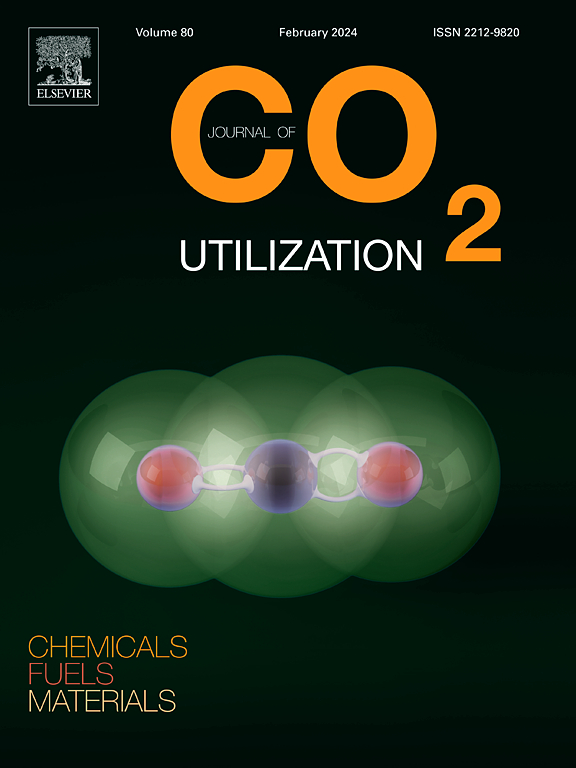Capturing microalgae within aerosols provides carbon capture bio-functionality
IF 7.2
2区 工程技术
Q1 CHEMISTRY, MULTIDISCIPLINARY
引用次数: 0
Abstract
Climate change due to the greenhouse effect poses arguably the greatest challenge to humanity. Addressing the sources of CO2 and reducing current atmospheric levels is the paramount task for scientists and engineers. Carbon capture with storage or utilization technologies are key to achieving this goal. Biological carbon fixation is an effective method of converting pollutant CO2 into usable biochemicals for industrial applications. Inspired by recent evidence that 95 % of CO2 from aerosol emissions from an Australian forest fire was captured by algae in the Southern Ocean, as well as the ability of algae to be transported within aerosols, we propose a novel technique for CO2 sequestration based on creating aerosols containing metabolically active cyanobacteria. Using aerosols as a microenvironment for Synechocystis cells enables a significant increase in gas-liquid-interfacial-surface-area while reducing the volume of water required. We utilize electron microscopy and hyperspectral microscopy to assess the effects of aerosolization and high CO2 concentrations on microbial cell viability. Additionally, we implemented highspeed imaging and oil immersion microscopy to determine the effectiveness of the aerosolization technique for forming aerosols and optimizing process parameters. We show that 1 % CO2 (v/v) is ideal for CO2 capture, where cell stress was minimized. Using cell densities of 1.2 × 108 cell/mL was the most efficient in terms of the number of cells aerosolized when compared to the input cell density. We report a 6-fold increase in carbon fixation rates (gCO2 g−1 biomass hr−1) over alternative popular cultivation techniques such as bubble columns.
在气溶胶中捕获微藻,实现碳捕获生物功能
温室效应导致的气候变化可以说是人类面临的最大挑战。解决二氧化碳的来源并降低目前大气中的二氧化碳含量是科学家和工程师的首要任务。碳捕集与封存或利用技术是实现这一目标的关键。生物固碳是一种有效的方法,可将污染物二氧化碳转化为可用于工业的生化物质。最近有证据表明,澳大利亚森林大火气溶胶排放的二氧化碳有 95% 被南大洋的藻类捕获,而且藻类能够在气溶胶中迁移,受此启发,我们提出了一种新的二氧化碳封存技术,该技术的基础是制造含有代谢活跃的蓝藻的气溶胶。利用气溶胶作为蓝藻细胞的微环境,可以显著增加气液界面面积,同时减少所需的水量。我们利用电子显微镜和高光谱显微镜来评估气溶胶和高浓度二氧化碳对微生物细胞活力的影响。此外,我们还采用了高速成像和油浸显微镜来确定气溶胶技术在形成气溶胶和优化工艺参数方面的有效性。我们的研究表明,1% CO2(v/v)是捕获二氧化碳的理想条件,可将细胞压力降至最低。与输入细胞密度相比,细胞密度为 1.2 × 108 cells/mL 的气溶胶细胞数量效率最高。我们报告的碳固定率(gCO2 g-1 生物量 hr-1)比其他流行的培养技术(如气泡柱)提高了 6 倍。
本文章由计算机程序翻译,如有差异,请以英文原文为准。
求助全文
约1分钟内获得全文
求助全文
来源期刊

Journal of CO2 Utilization
CHEMISTRY, MULTIDISCIPLINARY-ENGINEERING, CHEMICAL
CiteScore
13.90
自引率
10.40%
发文量
406
审稿时长
2.8 months
期刊介绍:
The Journal of CO2 Utilization offers a single, multi-disciplinary, scholarly platform for the exchange of novel research in the field of CO2 re-use for scientists and engineers in chemicals, fuels and materials.
The emphasis is on the dissemination of leading-edge research from basic science to the development of new processes, technologies and applications.
The Journal of CO2 Utilization publishes original peer-reviewed research papers, reviews, and short communications, including experimental and theoretical work, and analytical models and simulations.
 求助内容:
求助内容: 应助结果提醒方式:
应助结果提醒方式:


